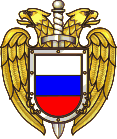Federal Protective Service (Russia)
| Federal Protective \ Федеральная служба охраны России | |
|---|---|
| Common name | Federal Protective Service |
| Abbreviation | FSO |
|
The emblem of the FSO | |
| Agency overview | |
| Formed | May 27, 1996 |
| Preceding agency | Glavnoye Upravlenie Okhrani (GUO) |
| Annual budget | classified |
| Legal personality | Governmental: Government agency |
| Jurisdictional structure | |
| Federal agency | RUS |
| Governing body | Presidential Administration of Russia |
| Constituting instrument | Law On State Protection |
| General nature |
|
| Specialist jurisdiction | Protection of international or domestic VIPs, protection of significant state asseets. |
| Operational structure | |
| Headquarters | The Kremlin, Moscow |
| Agency executive | General Dmitry Kochnev, Director |
| Child agency | Presidential Security Service (Russia) |
| Website | |
| http://www.fso.gov.ru/ | |
The Federal Protective Service (FSO) (Russian: Федеральная служба охраны, ФСО (Federalnaya Sluzhba Okhrany) of the Russian Federation, official name in English Federal Guard Service of the Russian Federation[1]) is a federal government agency concerned with the tasks related to the protection of several, mandated by the relevant law, high-ranking state officials, including the President of Russia, as well as certain federal properties. It traces its origin to the USSR's Ninth Chief Directorate of the KGB and later Presidential Security Service (SBP) led by KGB general Alexander Korzhakov.
On May 27, 1996, the law "On State Protection" reorganized the GUO (Glavnoye Upravlenie Okhrani) into the FSO (Federal Protection Service). Under article 7 of the law, "the President of the Russian Federation, while in office, shall not be allowed to forgo state protection."[2]
FSO includes the Russian Presidential Security Service.[3] This president's personal security is directed by Viktor Zolotov who, according to Sergei Tretiakov, also supervises the entire FSO.[4][5]
Structure and command
Since May 18, 2000 and until May 26, 2016 the agency was headed by General Evgeny Murov; since May 26, 2016 the head of the service is General Dmitry Kochnev. The FSO has roughly 50,000 uniformed personnel plus several thousand plainclothed personnel and controls the Cheget that can be used in the event of global nuclear war. It also operates a secure communications system for senior government officials. The FSO is a powerful institution with a range of rights and powers, including the right to conduct searches and surveillance without warrants, make arrests, and give orders to other state agencies.
One of the FSO units is the Kremlin Regiment. A more recent addition to the FSO infrastructure is the Special Communications Service of Russia (Spetsviaz) which was incorporated as a structural sub unit on August 7, 2004.
History of the federal protective services
- Special department by VChK College
- Special department of GPU
- Special department by OGPU College – Dec 1929
- 5th department (special safeguard) of Operod, SOU OGPU, Jan 1930 – Mar 1931
- 5th department (special safeguard) of Operod, SOU OGPU, Mar–Jun 1931
- 4th department of Operod, OGPU, Jun 1931
- Operod of OGPU
- Operative division (Operod) of GUGB NKVD USSR, Jul 1934 – Nov 1936
- Division of safeguard by GUGB NKVD USSR, Dec 1936 – Jun 1938
- Department of Moscow Kremlin's commandant, NKVD USSR
- 1st division of 1st Department by NKVD USSR, Jun–Sep 1938
- 1st division of GUGB
- 1st division of NKGB
- Department of Moscow Kremlin's commandant, NKGB USSR
- 1st division of NKVD
- Department of Moscow Kremlin's commandant, NKVD USSR
- Sixth department of NKGB USSR, Apr 1943 – Mar 1946
- Department of Moscow Kremlin's commandant, NKGB USSR
- Sixth department of MGB USSR, Mar–Apr 1946
- Department of safeguard No. 1, MGB, Apr–Dec 1946
- Department of safeguard No. 2, MGB, Apr–Dec 1946
- Department of Moscow Kremlin's commandant, MGB USSR, Dec 1946
- Headquarters of safeguard, MGB USSR, Dec 1946 – May 1952
- Department of safeguard, MGB, May 1952
- Ninth department of MVD USSR, Mar 1953 – Mar 1954
- Tenth department of MVD USSR, Mar 1953 – Mar 1954
- Ninth department of KGB by SM USSR, Mar 1954 –
- Tenth department of KGB by SM USSR, Mar 1954 –
- Fifteenth department of KGB by SM USSR
- Ninth department of KGB USSR
- Fifteenth department of KGB USSR
- Service of safeguard, KGB USSR
- Department of safeguard by USSR President
- Main Administration of Protection (GUO – Glavnoye Upravlenie Okhrani) (1992–1996)
- Federal Protective Service (FSO) (1996–today)[6]
See also
- Presidential Security Service (SBP)
- Federal Security Service (FSB)
- Kremlin Regiment
- Spetssvyaz
- FAPSI
- Awards of the Federal Protective Service of the Russian Federation
References
- ↑ (English) Federal Guard Service of the Russian Federation Archived March 13, 2012, at the Wayback Machine.
- ↑ (Russian) Статья 7 Федерального Закона О государственной охране 1996 года
- ↑ Service of President's Security (Служба безопасности Президента) by Agentura.Ru
- ↑ Pete Earley. Comrade J.: The Untold Secrets of Russia's Master Spy in America after the End of the Cold War, Putnam Adult (January 24, 2008), ISBN 0-399-15439-6, pages 298–301.
- ↑ Померяться силами Grani.ru May 15, 2008.
- ↑ The FSB control


